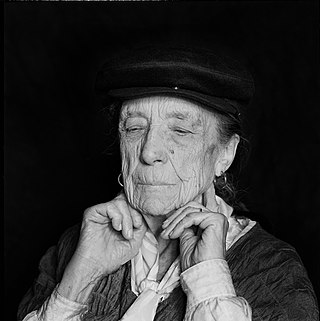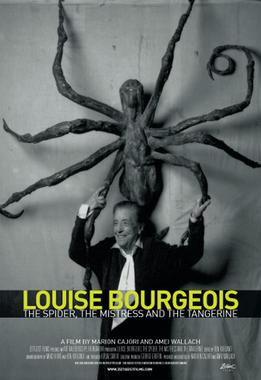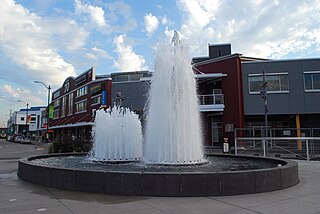
Tracey Karima Emin is an English artist known for autobiographical and confessional artwork. She produces work in a variety of media including drawing, painting, sculpture, film, photography, neon text and sewn appliqué. Once the "enfant terrible" of the Young British Artists in the 1980s, Tracey Emin is now a Royal Academician.

Louise Joséphine Bourgeois was a French-American artist. Although she is best known for her large-scale sculpture and installation art, Bourgeois was also a prolific painter and printmaker. She explored a variety of themes over the course of her long career including domesticity and the family, sexuality and the body, as well as death and the unconscious. These themes connect to events from her childhood which she considered to be a therapeutic process. Although Bourgeois exhibited with the abstract expressionists and her work has much in common with Surrealism and feminist art, she was not formally affiliated with a particular artistic movement.

Louise Lawler is a U.S. artist and photographer living in Brooklyn, New York. From the late 1970s onwards, Lawler’s work has focused on photographing portraits of other artists’ work, giving special attention to the spaces in which they are placed and methods used to make them. Examples of Lawler's photographs include images of paintings hanging on the walls of a museum, paintings on the walls of an art collector's opulent home, artwork in the process of being installed in a gallery, and sculptures in a gallery being viewed by spectators.

Doris Salcedo is a Colombian-born visual artist and sculptor. Her work is influenced by her experiences of life in Colombia and is generally composed of commonplace items such as wooden furniture, clothing, concrete, grass, and rose petals. Salcedo's work gives form to pain, trauma, and loss, while creating space for individual and collective mourning. These themes stem from her own personal history. Members of her own family were among the many people who have disappeared in politically troubled Colombia. Much of her work deals with the fact that, while the death of a loved one can be mourned, their disappearance leaves an unbearable emptiness. Salcedo lives and works in Bogotá, Colombia.

Maman (1999) is a bronze, stainless steel, and marble sculpture in several locations by the artist Louise Bourgeois. The sculpture, which depicts a spider, is among the world's largest, measuring over 30 ft high and over 33 ft wide (927 x 891 x 1024 cm). It includes a sac containing 32 marble eggs and its abdomen and thorax are made of rubbed bronze.

Jeffrey Lynn Koons is an American artist recognized for his work dealing with popular culture and his sculptures depicting everyday objects, including balloon animals produced in stainless steel with mirror-finish surfaces. He lives and works in both New York City and his hometown of York, Pennsylvania. His works have sold for substantial sums, including at least two record auction prices for a work by a living artist: US$58.4 million for Balloon Dog (Orange) in 2013 and US$91.1 million for Rabbit in 2019.

Louise Bourgeois: The Spider, the Mistress and the Tangerine is a 2008 documentary film about artist and sculptor Louise Bourgeois directed by Marion Cajori and Amei Wallach and distributed by Zeitgeist Films.
Tête is a limestone sculpture by Amedeo Modigliani and is amongst the most expensive works of art ever sold. In 2010 an anonymous telephone bidder purchased Tête for €43.2 million at Christie's in Paris. The sale was a record at a French auction and placed the sculpture amongst the most expensive ever sold. An anonymous telephone bidder won the auction. Since 1927 the piece had been in the collection of Gaston Lévy, an artist and acquaintance of Modigliani.

The ruling family of Qatar, the House of Thani, is deeply involved in the art field. For more than twenty years, some of its members have been accumulating numerous precious pieces of artwork.
The Qatar Museums (QM) Public Art Department is responsible for overseeing the installation of artwork by renowned artists in the public realm in Qatar, creating an artist residency program for young local artists to help them develop their skills and horizons, organizing exhibitions featuring international artists and developing an online community of creative talent in Qatar and beyond. The QM has an ambitious plan that aims to make Qatar a world class cultural destination, notably in modern and contemporary art.

The Femme Maison (1946–47) series of paintings by French American artist Louise Bourgeois address the question of female identity. In these paintings, the heads and bodies of nude female figures have been replaced by architectural forms such as buildings and houses. Femme Maison translates from the French as ‘housewife’: literally, ‘woman house’. In 1984 Bourgeois produced a small series of Femme Maison prints based on the works of 1947.
Paule Isabelle Anglim was a Canadian-born gallerist, dealer, and curator. She founded and directed Gallery Paule Anglim in San Francisco for approximately four decades before her death on April 2, 2015. According to a tribute written about her in SF Gate April 2, 2015, Anglim "endeared herself to the artists she handled with her unflinching commitment to work that she believed in. Her exhibitions encompassed the work of defining figures of the Bay Area Beat era and conceptual art sensibility, such as David Ireland, Paul Kos, Tom Marioni and Jim Melchert."

Enfants Terribles also Nana ET Matvey is an artist duo consisting of Nana Rosenørn Holland Bastrup and Matvey Slavin. The duo was founded in Hamburg in 2012 and named after their installation Enfants Terribles which, in May 2012, was exhibited on the large paved area outside the Hamburger Kunsthalle in Hamburg. The installation Enfants Terribles was a homage to the spider sculpture Maman by Louise Bourgeois, and consisted of sixteen baby spiders around Bourgeois' existing sculpture.

The John and Mary Pappajohn Sculpture Park is a 4.4-acre (1.8 ha) park within Western Gateway Park in Des Moines, Iowa. It opened in 2009 with 24 sculptures, with four more acquired later. The sculpture park is administered by the Des Moines Art Center and contains works by artists such as Louise Bourgeois, Jaume Plensa, Ai Weiwei, and Barry Flanagan. It is considered "one of the most significant collections of outdoor sculptures in the United States".

Father and Son is an outdoor 2005 fountain and sculpture by Louise Bourgeois, installed at Olympic Sculpture Park in Seattle, Washington. It is made of stainless steel, aluminum and features a bronze bell.
Rabbit is a 1986 series of three identical stainless steel sculptures by Jeff Koons. One of the editions of Rabbit is the most expensive work sold by a living artist at auction, being sold for $91.1 million in May 2019.

Michael Joseph Winkelmann, known professionally as Beeple, is an American digital artist, graphic designer, and animator known for selling NFTs. In his art, he uses various media to create comical, phantasmagoric works that make political and social commentary while using pop culture figures as references. British auction house Christie's has called him "A visionary digital artist at the forefront of NFTs". Beeple was introduced to NFTs in October 2020 and credits Pak for providing his first "primer" on selling NFTs. The NFT associated with Everydays: the First 5000 Days, a collage of images from his "Everydays" series, was sold on March 12, 2021, for $69 million in cryptocurrency to an investor in NFTs. It is the first purely non-fungible token to be sold by Christie's. The auction house had previously sold Block 21, an NFT with accompanying physical painting for approximately $130,000 in October 2020.













